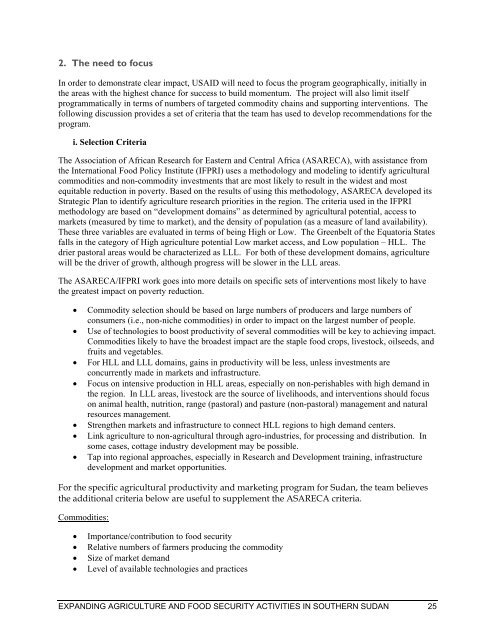expanding agriculture and food security activities in ... - part - usaid
expanding agriculture and food security activities in ... - part - usaid
expanding agriculture and food security activities in ... - part - usaid
You also want an ePaper? Increase the reach of your titles
YUMPU automatically turns print PDFs into web optimized ePapers that Google loves.
2. The need to focus<br />
In order to demonstrate clear impact, USAID will need to focus the program geographically, <strong>in</strong>itially <strong>in</strong><br />
the areas with the highest chance for success to build momentum. The project will also limit itself<br />
programmatically <strong>in</strong> terms of numbers of targeted commodity cha<strong>in</strong>s <strong>and</strong> support<strong>in</strong>g <strong>in</strong>terventions. The<br />
follow<strong>in</strong>g discussion provides a set of criteria that the team has used to develop recommendations for the<br />
program.<br />
i. Selection Criteria<br />
The Association of African Research for Eastern <strong>and</strong> Central Africa (ASARECA), with assistance from<br />
the International Food Policy Institute (IFPRI) uses a methodology <strong>and</strong> model<strong>in</strong>g to identify agricultural<br />
commodities <strong>and</strong> non-commodity <strong>in</strong>vestments that are most likely to result <strong>in</strong> the widest <strong>and</strong> most<br />
equitable reduction <strong>in</strong> poverty. Based on the results of us<strong>in</strong>g this methodology, ASARECA developed its<br />
Strategic Plan to identify <strong>agriculture</strong> research priorities <strong>in</strong> the region. The criteria used <strong>in</strong> the IFPRI<br />
methodology are based on “development doma<strong>in</strong>s” as determ<strong>in</strong>ed by agricultural potential, access to<br />
markets (measured by time to market), <strong>and</strong> the density of population (as a measure of l<strong>and</strong> availability).<br />
These three variables are evaluated <strong>in</strong> terms of be<strong>in</strong>g High or Low. The Greenbelt of the Equatoria States<br />
falls <strong>in</strong> the category of High <strong>agriculture</strong> potential Low market access, <strong>and</strong> Low population – HLL. The<br />
drier pastoral areas would be characterized as LLL. For both of these development doma<strong>in</strong>s, <strong>agriculture</strong><br />
will be the driver of growth, although progress will be slower <strong>in</strong> the LLL areas.<br />
The ASARECA/IFPRI work goes <strong>in</strong>to more details on specific sets of <strong>in</strong>terventions most likely to have<br />
the greatest impact on poverty reduction.<br />
• Commodity selection should be based on large numbers of producers <strong>and</strong> large numbers of<br />
consumers (i.e., non-niche commodities) <strong>in</strong> order to impact on the largest number of people.<br />
• Use of technologies to boost productivity of several commodities will be key to achiev<strong>in</strong>g impact.<br />
Commodities likely to have the broadest impact are the staple <strong>food</strong> crops, livestock, oilseeds, <strong>and</strong><br />
fruits <strong>and</strong> vegetables.<br />
• For HLL <strong>and</strong> LLL doma<strong>in</strong>s, ga<strong>in</strong>s <strong>in</strong> productivity will be less, unless <strong>in</strong>vestments are<br />
concurrently made <strong>in</strong> markets <strong>and</strong> <strong>in</strong>frastructure.<br />
• Focus on <strong>in</strong>tensive production <strong>in</strong> HLL areas, especially on non-perishables with high dem<strong>and</strong> <strong>in</strong><br />
the region. In LLL areas, livestock are the source of livelihoods, <strong>and</strong> <strong>in</strong>terventions should focus<br />
on animal health, nutrition, range (pastoral) <strong>and</strong> pasture (non-pastoral) management <strong>and</strong> natural<br />
resources management.<br />
• Strengthen markets <strong>and</strong> <strong>in</strong>frastructure to connect HLL regions to high dem<strong>and</strong> centers.<br />
• L<strong>in</strong>k <strong>agriculture</strong> to non-agricultural through agro-<strong>in</strong>dustries, for process<strong>in</strong>g <strong>and</strong> distribution. In<br />
some cases, cottage <strong>in</strong>dustry development may be possible.<br />
• Tap <strong>in</strong>to regional approaches, especially <strong>in</strong> Research <strong>and</strong> Development tra<strong>in</strong><strong>in</strong>g, <strong>in</strong>frastructure<br />
development <strong>and</strong> market opportunities.<br />
For the specific agricultural productivity <strong>and</strong> market<strong>in</strong>g program for Sudan, the team believes<br />
the additional criteria below are useful to supplement the ASARECA criteria.<br />
Commodities:<br />
• Importance/contribution to <strong>food</strong> <strong>security</strong><br />
• Relative numbers of farmers produc<strong>in</strong>g the commodity<br />
• Size of market dem<strong>and</strong><br />
• Level of available technologies <strong>and</strong> practices<br />
EXPANDING AGRICULTURE AND FOOD SECURITY ACTIVITIES IN SOUTHERN SUDAN 25

















